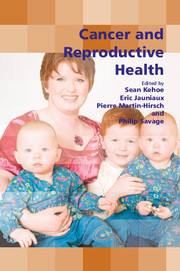Book contents
- Frontmatter
- Contents
- Participants
- Preface
- SECTION 1 Epidemiology, Genetics and Basic Principles of Chemotherapy and Radiotherapy
- SECTION 2 Fertility Issues and Paediatric Cancers
- 5 Assisted reproductive technology for preserving fertility in women with cancer
- 6 Fertility after cancer therapy
- 7 Fertility-preserving surgery in women with cancer of the cervix
- 8 Gonadal function and fertility issues in children and young people treated for cancer
- SECTION 3 Gynaecological Cancers and Precancer
- SECTION 4 Diagnostic Dilemmas
- SECTION 5 The Placenta
- SECTION 6 Non-Gynaecological Cancers
- SECTION 7 Multidisciplinary Care and Service Provision
- SECTION 8 Consensus Views
- Index
7 - Fertility-preserving surgery in women with cancer of the cervix
from SECTION 2 - Fertility Issues and Paediatric Cancers
Published online by Cambridge University Press: 05 October 2014
- Frontmatter
- Contents
- Participants
- Preface
- SECTION 1 Epidemiology, Genetics and Basic Principles of Chemotherapy and Radiotherapy
- SECTION 2 Fertility Issues and Paediatric Cancers
- 5 Assisted reproductive technology for preserving fertility in women with cancer
- 6 Fertility after cancer therapy
- 7 Fertility-preserving surgery in women with cancer of the cervix
- 8 Gonadal function and fertility issues in children and young people treated for cancer
- SECTION 3 Gynaecological Cancers and Precancer
- SECTION 4 Diagnostic Dilemmas
- SECTION 5 The Placenta
- SECTION 6 Non-Gynaecological Cancers
- SECTION 7 Multidisciplinary Care and Service Provision
- SECTION 8 Consensus Views
- Index
Summary
Introduction
While cervical cancer remains the second most common female tumour with over 500 000 cases per year, the incidence has fallen dramatically in countries that have introduced successful screening programmes, predominantly in the western world. As a result, in those countries there has been a disproportionate rise in the incidence of cervical precancer or intraepithelial neoplasia as well as early-stage disease, especially of glandular tumours. There has thus been an increase in demand for fertility-sparing techniques to be developed.
Standard treatment for cervical cancer has until recently been either radical hysterectomy or radiotherapy to the pelvis. Both will result in future childbearing being impossible. A radical wide local excision of carefully selected early-stage tumours will allow conservation of the body of the uterus with a vaginoisthmic anastomosis enabling continuity of the vagina to be preserved following insertion of an isthmic cerclage suture. Pelvic node dissection may be performed at the same time by laparoscopic techniques.
Over 900 cases have been performed and reported in the worldwide literature. Most have been carried out vaginally (radical vaginal trachelectomy and laparoscopic pelvic node dissection). A smaller number have been performed abdominally. There have been over 300 pregnancies reported, with 196 live births. This technique is suitable in well-selected cases in young women with small tumours who are well motivated to preserve their fertility potential.
Keywords
- Type
- Chapter
- Information
- Cancer and Reproductive Health , pp. 87 - 100Publisher: Cambridge University PressPrint publication year: 2008
- 1
- Cited by



